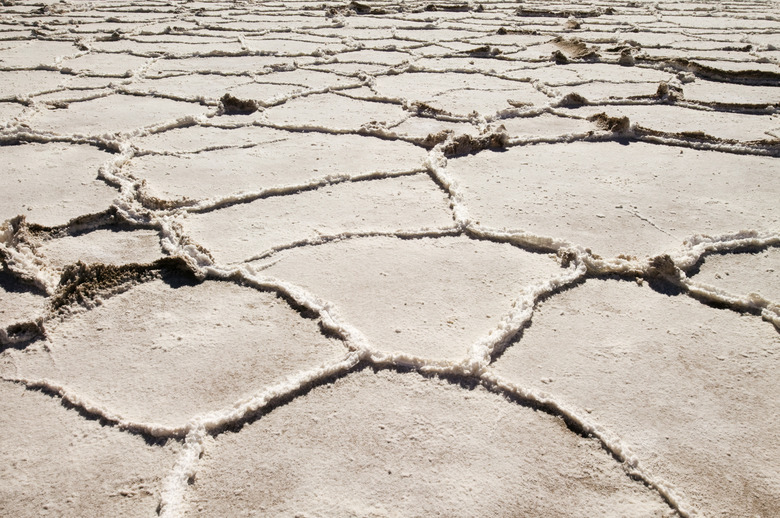Salt On Other Planets
Earth is the only planet in the solar system with large quantities of surface water, and with water comes all the things that dissolve in it, including salt. In fact, salt is such an important component of seawater that evidence of it on other planets points to the past or present existence of water and possibly life. Salt isn't easy to detect, but there is evidence for it on other planets.
Terrestrial Ocean Salinity
Terrestrial Ocean Salinity
Most of the salt in Earth's oceans is sodium chloride, which is the same salt you find on the dinner table, but there are other salts as well, including potassium chloride, sodium bromide and potassium fluoride. The salinity of the world's oceans, which averages around 35 parts per thousand, is an important regulator of metabolism, both for marine and terrestrial life. Salinity increases in a land-locked sea as the water evaporates until the sea can no longer support life, and all that's left is a whitish or grayish surface deposit. Utah's Bonneville Salt Flats is a well-known example of such a deposit.
Salt on Mars
Salt on Mars
In 2008, a team of scientists from the University of Hawaii and Arizona State University reported the discovery of deposits of chloride minerals — which are salts — in basins and valleys on Mars. The discovery was the result of analyzing spectral data from a multiwavelength camera aboard NASA's Mars Odyssey orbiter. The deposits occur in low-lying areas surrounded by channels and fissures consistent with the erosion caused by running water. Because the deposits are isolated from each other, scientists don't believe Mars had an ocean. It's more likely that groundwater welled up to the surface and evaporated.
Salt on Europa
Salt on Europa
Scientists have long agreed that Jupiter's moon Europa harbors a planetary ocean of liquid water beneath its thin crust. Early in 2013, astronomers Mike Brown and Kevin Hand reported evidence of an interchange between the surface crust and the subterranean ocean, and they also reported detecting the spectroscopic signature of epsomite, which on Earth is known as Epsom salts. They detected magnesium sulfate and magnesium chloride, too. The scientists surmise that the magnesium could only come from the oceans, suggesting that Europa's oceans may be as salty as those on Earth, and therefore capable of supporting life.
Salt on Enceladus
Salt on Enceladus
Soon after it entered orbit in around Saturn in 2004, the Cassini spacecraft detected a plume of water and ice emanating from the south pole of Enceladus, one of the Saturnian moons. Cassini passed through the plume in 2008 and found salt-rich grains of ice close to the moon's surface, suggesting the presence of a salt ocean beneath the crust. The salt-poor grains end up being ejected from the moon and forming Saturn's E-ring, but the salt-rich ones, which are heavier, fall back to the surface. Scientists believe that Enceladus has a watery layer about 80.5 kilometers (50 miles) below its surface, and they now have evidence that the water is salty.
Cite This Article
MLA
Deziel, Chris. "Salt On Other Planets" sciencing.com, https://www.sciencing.com/salt-other-planets-23945/. 24 April 2017.
APA
Deziel, Chris. (2017, April 24). Salt On Other Planets. sciencing.com. Retrieved from https://www.sciencing.com/salt-other-planets-23945/
Chicago
Deziel, Chris. Salt On Other Planets last modified March 24, 2022. https://www.sciencing.com/salt-other-planets-23945/
